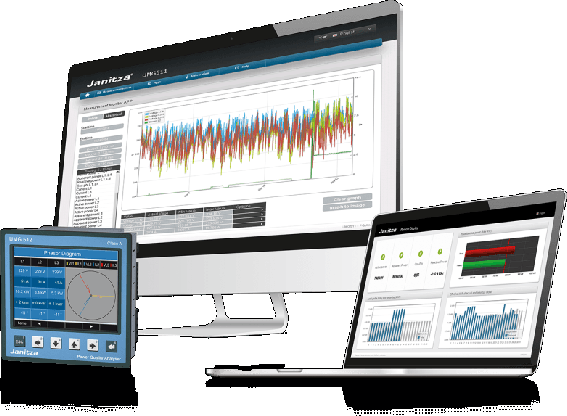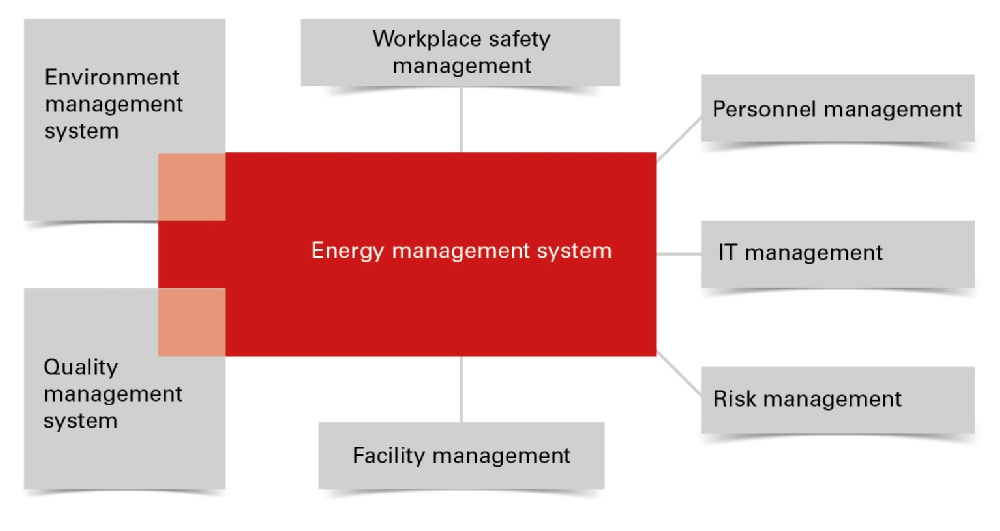



Leo Advanced Technologies Ltd. Caritas Street 1, 32000 Bethlehem, Palestinian Autonomy, Via Israel . © 2016






PREMIUM PARTNER
EMS energy management systems based on EN16001 / ISO 50001
EMS energy management systems based on EN16001 / ISO 50001
Increasing energy prices, the discussion on stopping nuclear energy production entirely, dwindling fossil-
Legal guidelines and regulations lend further impetus. Numerous investigations and studies (e.g. European Commission, DENA, Fraunhofer Institute) show that, in many cases, there is a considerable savings potential of up to 30 % and more.
EN 16001, a standard for energy management systems (EMS), was first released by the European Committee for Standardization (CEN) in July 2009. The general aim of this standard is to support organisations in the set-
The task of an energy management system is to determine the energy situation in the organisation, to redefine the energy policy of a company based on concrete data and to improve the energy efficiency. Furthermore, factors that influence energy consumption must be identified in order to continuously monitor and measure them. The energy manager of a company is responsible for pursuing the defined goals and continually improving the results achieved.
The decisive component in an energy management system is an effective and continuous energy controlling control circuit (Fig. 1). A control circuit of this type consists of the 4 stages: data acquisition, energy analysis, energy efficiency measures and inspection:

1) Continuous data acquisition and measurement:
A first step to escape the financial trap is the precise acquisition of all energy data, electrical and voltage quality parameters. First of all, the operating, consumption, and cost data (e.g. power, gas and district heating invoices) must be acquired and recorded by qualified personnel during the data acquisition phase. To make a detailed evaluation of an organisation and to create a basis for relevant energy efficiency measures, the energy flows must be further resolved from the supply side all the way down, which means major consumers or company units must also be measured and sub-
Via corresponding communication architectures (communication connection, Fig. 3), the acquired data is transmitted to a central location, stored centrally in high-
2) Energy analysis (target-
The energy analysis is based on the data of the automatic measurement data acquisition system. The energy analysis provides the basis for the concrete goals of the enterprise with regard to energy consumption and energy cost reduction (e.g. 10 % energy savings a year). In addition, the energy analysis results are also the significant starting point for an ABC analysis of the consumers, the development of a catalogue of measures, evaluation of specific measures, prioritisation of the energy efficiency measures and creation of a detailed plan of measures.
3) Planning and design of energy efficiency measures:
The results of the energy analysis flow into the planning of measures for reducing the energy consumption and energy costs. The measures can be divided into four groups:
Planning: Examination of energy use, optimisation of operating times, machines with high efficiency, peak load optimisation, heat recovery…
Organisational measures: Area of acquisition (e.g. putting emphasis on the life cycle costs), changes to the workflow, in the area of regulation/control, the conduct of employees, during maintenance and repair, training and motivation
Technical measures: Use of more energy efficient motors (more than 95 % of the life cycle costs of an electrical drive are energy costs), changing to frequency inverters, use of heat recovery, leakage reduction in the compressed air network, optimisation of the regulation and control of systems, optimisation of steam generation, intelligent use of peak load optimisation/energy storage…
Load management: Load management constitutes a special measure. Optimisation of the power load profile does not primarily bring energy savings but, depending on the power supplier contract, leads to substantial cost savings. This measure also stabilises the energy supply.
4) Checking and correction:
What is the point of an energy management system?
The identification of "energy wasters" and introduction of measures results in the reduction of power and energy costs (kWh, peak load costs, reactive power costs)
Reduction of climate killing carbon dioxide (Green IT, Zero carbon offices, Kyoto …)
Stabilisation of processes (improvement of the power quality)
Maintenance costs are lowered by pro-
Power failures, e.g. due to harmonic oscillations, voltage drops or transients, are avoided
Greater awareness of employees with regard to energy savings and climate protection
Fulfilment of legal framework guidelines, energy tax reduction
Cost centre management enables consumption-
Environmental protection and corporate image cultivation
The power bill is usually the gauge for the cost calculation of operational plants, buildings or infrastructural facilities. However, this bill is only the visible part of sometimes much higher costs, taking a "dirty" and unreliable energy supply into account. Next to the direct electricity costs, the effective capacity utilisation of energy distribution systems and facilities as well as a reliable energy supply also play an important role in economic efficiency. As these costs are not so obvious, they are also referred to "hidden costs".
With an integrated, integral energy management system, you can also centrally monitor and compare (benchmark) branches at various geographical locations, for example. The power consumption, reactive power monitoring, water and gas consumption, the availability of electrical energy and the power quality can be collected, evaluated and analysed in the database at company headquarters. This can also increase energy efficiency as saving potentials are revealed by cost comparison.
Practically at the push of a button, the relevant software can be used to prepare the various data and create statistics and tables in the desired format, which are then made available to the financial controlling, the energy manager, the purchasing department or facility management. In the area of property management, this also means an improvement of the preciseness of power consumption accounts and convenient, automated, customer-
End-

| Electrical Installation & Energy Management |
| Building Automation |
| Training Systems |
| Other Services |